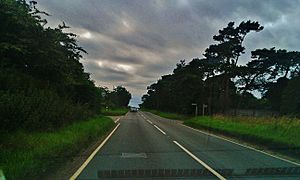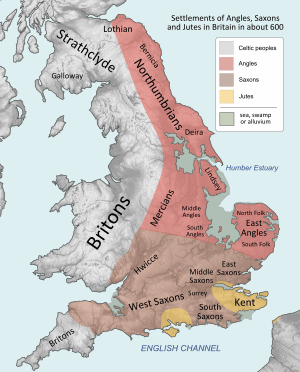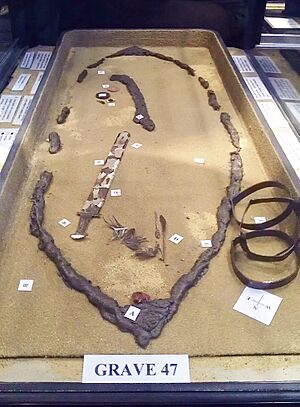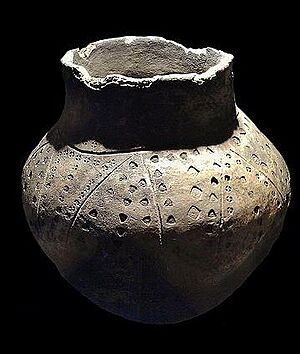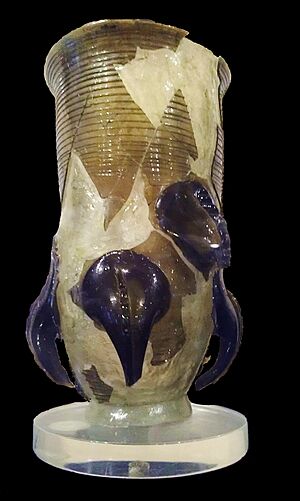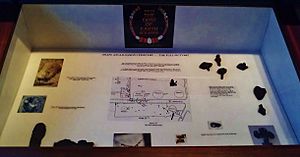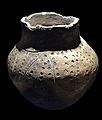Snape Anglo-Saxon Cemetery facts for kids
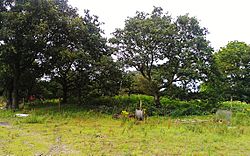
Mound 4, one of the cemetery's six tumuli, as of 2012.
|
|
| Lua error in Module:Location_map at line 420: attempt to index field 'wikibase' (a nil value). | |
| Established | 6th century AD |
|---|---|
| Location | Snape Common, Suffolk |
| Type | Ship burial |
The Snape Anglo-Saxon Cemetery is an ancient burial ground from the 6th century AD. It's located on Snape Common in Suffolk, Eastern England. This site is from the early part of the Anglo-Saxon Era in English history.
At Snape, people were buried in different ways. Both cremation (burning the body) and inhumation (burying the body) were used. The cemetery is also famous for a special ship burial, which was a very important way to bury someone. Some of these burials were placed inside large mounds of earth called tumuli.
The first time people dug at the site was in 1827. These early explorers were called antiquarians, people interested in old things. A more detailed dig happened in 1862, led by the landowner, Septimus Davidson. Sadly, many items from the first dig disappeared. But important finds from 1862 included a glass claw beaker and the Snape Ring. These are now kept at The British Museum in London.
Later, in the 20th century, the land where the cemetery was located became farmland. A road and a house were even built on top of the site. Today, you can't visit the burial mounds themselves. However, the amazing objects found during the digs are on display. You can see them at the Aldeburgh Moot Hall Museum in the nearby town of Aldeburgh.
Contents
Where is the Snape Cemetery?
The Snape Anglo-Saxon cemetery is in the north-east part of Snape parish. It's about 550 metres from the border with Friston. Even though some modern houses are on or near the cemetery, Snape village is 1.5 kilometres away. Friston village is a bit closer, at 1.25 kilometres.
The site is 2.5 kilometres north of the River Alde. It's also 7 kilometres west of the coastal town of Aldeburgh and the North Sea. The cemetery is 17 kilometres north-east of the more famous Anglo-Saxon ship burial at Sutton Hoo.
Before the 1900s, this area was a large heathland. This kind of land was mostly used for sheep grazing. By the 1800s, a road, now called the A1094, was built right through the cemetery. In the 1950s, much of the heathland became farmland. Farmers grew crops like potatoes and rye there. Part of the cemetery also became a house called St. Margaret's, with its own garden.
The soil here is acidic, which means most native British trees couldn't grow well. So, before pine trees were planted in the 20th century, you could probably see the River Alde and the sea from the burial mounds. You might have even seen the town of Iken.
Understanding the Anglo-Saxon Period
The Anglo-Saxon period brought big changes to the society, language, and culture of eastern Britain. We don't have many written records from the 5th and 6th centuries. Most of what we know comes from archaeology, especially from burial sites like Snape. We also have a few old texts, like one written by a monk named Gildas.
According to another monk named Bede, who wrote in the 8th century, the Anglo-Saxon age began when three groups of people moved to Britain. These were the Saxons, Angles, and Jutes from Northern Germany and Southern Denmark. They were first hired as soldiers by the local Romano-British people after the Roman Empire left Britain. Archaeology supports this, and also suggests another group, the Frisians, might have been there too.
These new settlers probably mixed with each other and with the local British people. They formed new groups and identities. They also kept connections with cultures in Scandinavia, Germany, and Northern France. They traded for fancy goods and told epic stories, like Beowulf, which were set in their old homelands. The Snape cemetery is in what was once the Anglo-Saxon Kingdom of East Anglia, which Bede said was settled by the Angle tribe.
What Was Found at Snape Cemetery?
The Snape Anglo-Saxon cemetery is about 200 metres long from east to west and 70 metres wide from north to south. About half of the burials were cremations, and half were inhumations. Unlike some other Anglo-Saxon cemeteries, at Snape, these different types of burials were mixed together. They were also from around the same time.
Archaeologists have found at least nine, and possibly ten, burial mounds (tumuli) at the site.
The Famous Ship Burial
The Snape cemetery is most famous for the boat burial found there in 1862. We know about its shape and style from notes and drawings made by Septimus Davidson and his team. The most accurate drawing is a watercolour painting kept at the Society of Antiquaries. This painting was made during or soon after the dig. We also have surviving metal parts, like rivets, which are now at Aldeburgh Moot Hall Museum.
The ship was at least 14 metres long and 3 metres wide. It was built using a method called clinker building, where wooden planks overlap. The planks were held together with rivets made of iron. These rivets were about 140 millimetres apart. The painting shows there were nine planks on each side.
The boat was placed facing east to west. It seems it once held the burial of a very important person. However, the grave had already been robbed before the 1863 excavation. This means many valuable items were probably taken. Still, Davidson's team found some things left behind. These included two iron spearheads, suggesting the person buried was male. They also found the gold Snape Ring and a glass claw beaker. Another find was first described as "human hair wrapped in cloth." Later, experts thought it might be a shaggy cloak, like those found at Sutton Hoo. Some fragments of jasper and blue glass were also found. Based on these items, experts believe the ship was buried around 550 CE.
Cremation Burials
Many people at Snape were cremated. This means their bodies were burned, and their ashes were often placed in special pots called urns. These urns were then buried.
Inhumation Burials
Inhumation burials mean the body was buried whole, without being burned. At Snape, these burials were found mixed in with the cremation burials.
Special Items Found at Snape
The Snape Ring
The most well-known item from Snape is the Snape Ring. It has a Roman onyx gemstone carved with a figure called Bonus Eventus. This gemstone is set into a large gold ring.
Some experts believe the Snape Ring was made in continental Europe, possibly by Frankish craftspeople in the early to mid-6th century. They think this because it looks very similar to Frankish jewelry from that time. Also, Roman gemstones set in Germanic styles are common in Europe but rare in Anglo-Saxon England.
The Glass Claw-Beaker
Another important find from the ship burial was a glass claw-beaker. This type of beaker has distinctive claw-like decorations on its sides. Experts believe it was made around the mid-sixth century.
How Snape Cemetery Was Explored
The first recorded dig at Snape happened in 1827. A group of gentlemen from London opened several mounds. They reportedly found "quantities of gold rings, brooches, chains etc." We don't know much about what they found or what happened to the items. It's also thought that the mounds were dug up again in the mid-1800s by people working for the Ordnance Survey, but no records of this have been found.
Davidson's Dig: 1862–1863
"Although none of the excavators appear to have had any previous excavation experience, or indeed special knowledge of archaeology, they nevertheless carried out the excavation in an exemplary way, for which we owe them a great debt. In the first place, they were not treasure hunters... The reason for the excavation was their own intellectual curiosity."
A more careful and organized excavation took place in 1862. It was led by Septimus Davidson, who owned part of the heathland. Davidson was a lawyer, not an archaeologist, but he was curious about the old mounds on his land. He was helped by a local surgeon, Dr Nicholas Hele, and two other men.
Even though they weren't trained archaeologists, they dug very carefully. They started in the middle of each mound and dug outwards. They also recorded where they found objects, like the ship rivets. Sometimes things went wrong, like when a spade broke a buried urn. Davidson, Hele, and one of the other helpers wrote about their findings. Davidson's report was shared in January 1863.
Davidson noted that there were either nine or ten mounds, with five being "large." He only dug into three large mounds that he owned, which had been damaged by traffic. In two of them, he found no graves. But in the third, he found the ship burial. He recorded it in great detail, which was unusual for the time. Our knowledge of this burial comes mostly from his notes. This was the first time a ship burial had been found and recognized in England. Two years earlier, people had dug through a boat burial at Sutton Hoo without realizing what it was. Ship burials had already been found in Scandinavia. Davidson was so excited that he returned the next year. He dug a long trench and found over forty pots and other items.
Later Discoveries: 1920–1985
In the 1920s, a house called St. Margaret's was built at the cemetery site. The mounds became part of the house's garden. People claimed that urns were found when the house was built and when trees were planted, but these finds were never confirmed or located. During the Second World War, the heathland was ploughed for farming, but no finds were reported. In 1951, mounds on the other side of the road were also ploughed, again with no reported finds.
In 1939, the discovery of the ship burial at Sutton Hoo became very famous. This made Snape seem less important for a while. But in 1952, archaeologist Rupert Bruce-Mitford wrote a paper summarizing Davidson's excavation. This helped bring Snape back into focus.
In 1970, a dowser (someone who claims to find things underground using rods) found an urn. In 1972, when a sewer trench was being dug, archaeologists were called to observe. They found nine cremations, some in urns and one in a bronze bowl. In the 1980s, scientists tried using special equipment like magnetometry and resistivity to map the site underground. However, these surveys didn't show much about the Anglo-Saxon features.
Filmer-Sankey's Dig: 1985–1992
New interest in Snape grew after new digs started at Sutton Hoo in 1983. The lead archaeologist, Martin Carver, stressed that Sutton Hoo needed to be understood with other sites like Snape.
Archaeologist William Filmer-Sankey led a new investigation at Snape. First, his team carefully studied all the old documents about previous digs. They learned that Snape mostly had cremation burials, even though the ship burial was the most famous part. This made them compare Snape to another cemetery called Spong Hill.
Then, they planned how to dig. Since other methods hadn't worked well, they decided to dig trenches. In 1985, they opened fourteen trenches. They found two cremation urns, but they were damaged by ploughing. One trench was made bigger, and they found two more urns and an inhumation burial. This made them change their digging plan.
From 1986 to 1988, the team dug a larger area near where the ship burial was thought to be. They found 17 cremation burials and 21 inhumation burials, including a smaller boat burial. From 1989 to 1990, they dug more trenches to find the edges of the cemetery.
In 1992, Filmer-Sankey wrote a summary of the digs up to that point. His full report on the Snape excavations was published in 2001.
Images for kids


